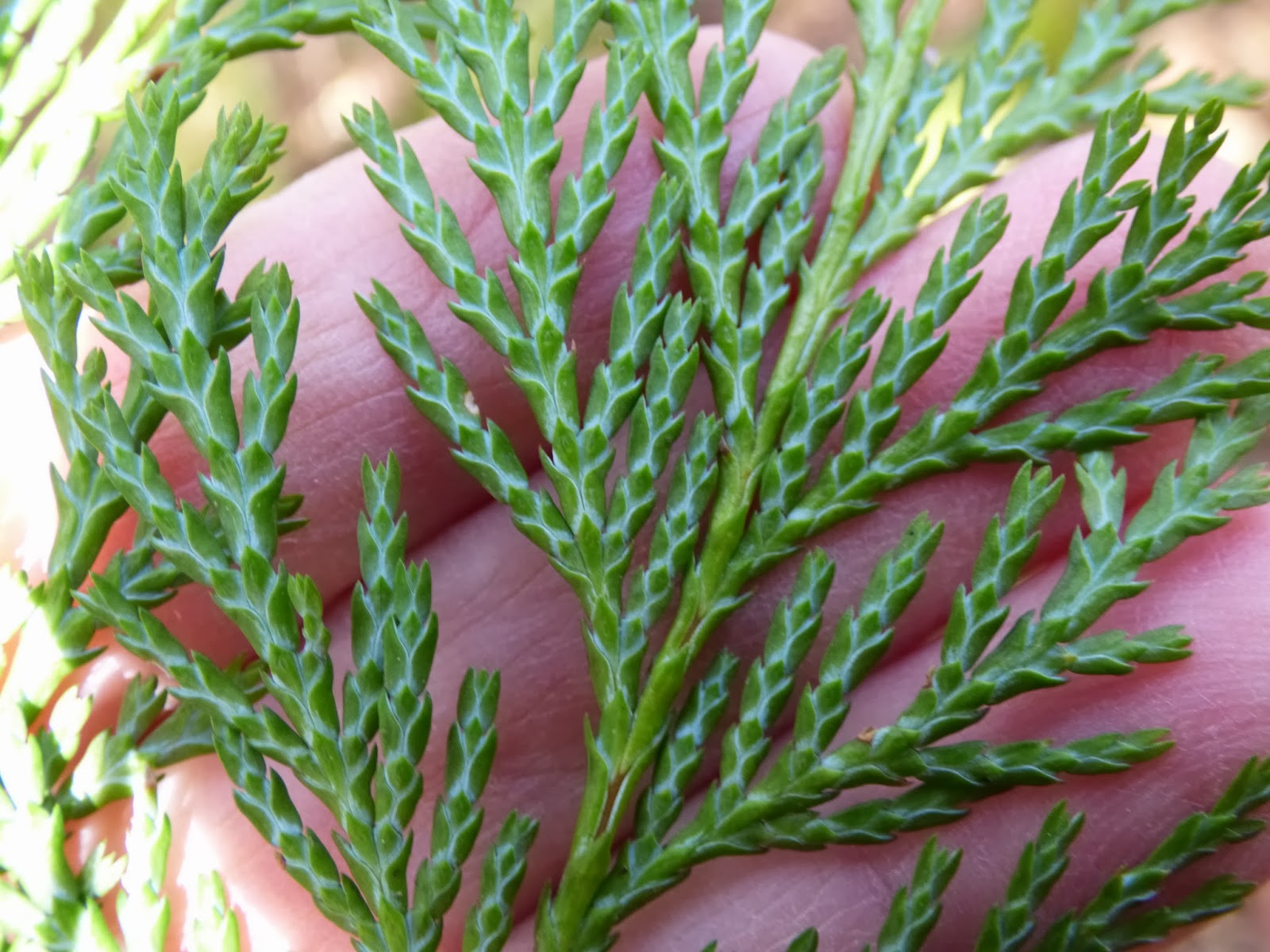Western Red Cedar has butterflies on the underside of its needles. They are really quite obvious on a twig in hand. We have Red Admiral butterflies in this part of Oregon, so that is how I remember that butterflies belong on Red Cedar (which is actually Thuja plicata, not even in the same genus as the other trees I call cedars.)
Port Orford Cedar (which is really a false Cypress: Chamaecyparis Lawsoniana and also called Lawson Cypress or Oregon Cedar) has quite obvious white Xs on the underside of its needles.
It is a lacy tree, but when grown in the shade in our woods by Agency Creek, I sometimes confuse it with the Western Red Cedar growing nearby. Western Red Cedar looks nothing like Port Orford Cedar when grown in the open... it turns red in the winter. Below is a Port Orford Cedar in our woods.
It was a challenge to come up with a way to associate X with Port Orford. Finally, I decided that X marks the spot on a map and Port Orford is a spot on the map. Lame, I know. But it helps me remember.
Alaska Yellow Cedar is another false cypress: Chamaecyparis nootkaensis. It looks rather different from the others, plus I have it planted in a different spot, with Sitka Spruce. The underside of its needles are not as obvious as the others. I finally decided they look like bouquets of yellow roses (since the undersides are yellowish on the new growth). So I think of the Yellow Rose of Texas and that reminds me of the Yellow Cedar of Alaska. Hey, it works for me.
Of course, I have no trouble telling which are Alaska Yellow Cedars for another reason: the deer love to rub their antlers on them. They are destroying my trees. The wood smells wonderful and must be a deer attractant. I have put tree protectors around them but the deer manage to rub them anyway.
The one below has been mangled many times but is still fighting its way upward.
The above was written 2014. Now it is 2017 and I am trying a new method of discouraging antler-rubbing deer. I hope it works. In the spring, I comb out Shirley Puppy's heavy under fur that keeps her warm all winter... at least I try. It is very thick. I have saved it for the purpose of hanging bags of it on my Alaska Yellow Cedars in hopes the smell will discourage the deer. (Shirley is no puppy anymore, btw; she is 11.)
Years ago I hung an old thick collar that we used to keep Shirley from crawling through fences (it didn't work) on one of the Quaking Aspens that the deer were rubbing on. That worked. I figured it was the smell of a predator... dog... that deterred the deer. So... we'll see if dog hair works as well. I have stuffed the hair into mesh orange bags and hung them from the poor, tortured trees. Here's hoping!
Update 2020: yes, the dog hair works but needs to be renewed every fall. I neglected last fall and had more deer rub damage. So now I keep a big sack of Shirley's brushed out undercoat for future use. Shirley is approaching 15 and has had a stroke and doggy dementia, but still toddling around and enjoying petting... and brushing.
My fourth "cedar", Incense Cedar (Calocedrus decurrens), has branchlets that twist every which way, but I still confuse it with Western Red Cedar if I don't check the needle undersides.
Incense Cedar has vases that one might use to hold incense sticks.
As for "real" cedars (Cedrus), I have two in our arboretum. Cedrus deodar is a little scrawny thing at the moment, having spent its first few years growing sideways and trying to climb out of the blackberry bushes. Once liberated, it straightened up, but still looked sickly when I took these photos in 2014.
My other Cedrus is atlantica. It looks alot like deodara to me, but with shorter needles. And bigger at the moment.
Obiously, the "real" cedars look nothing like the so-called cedars that have flat branchlets. The mystery is how all those non-Cedrus trees came to be called "cedars".





















